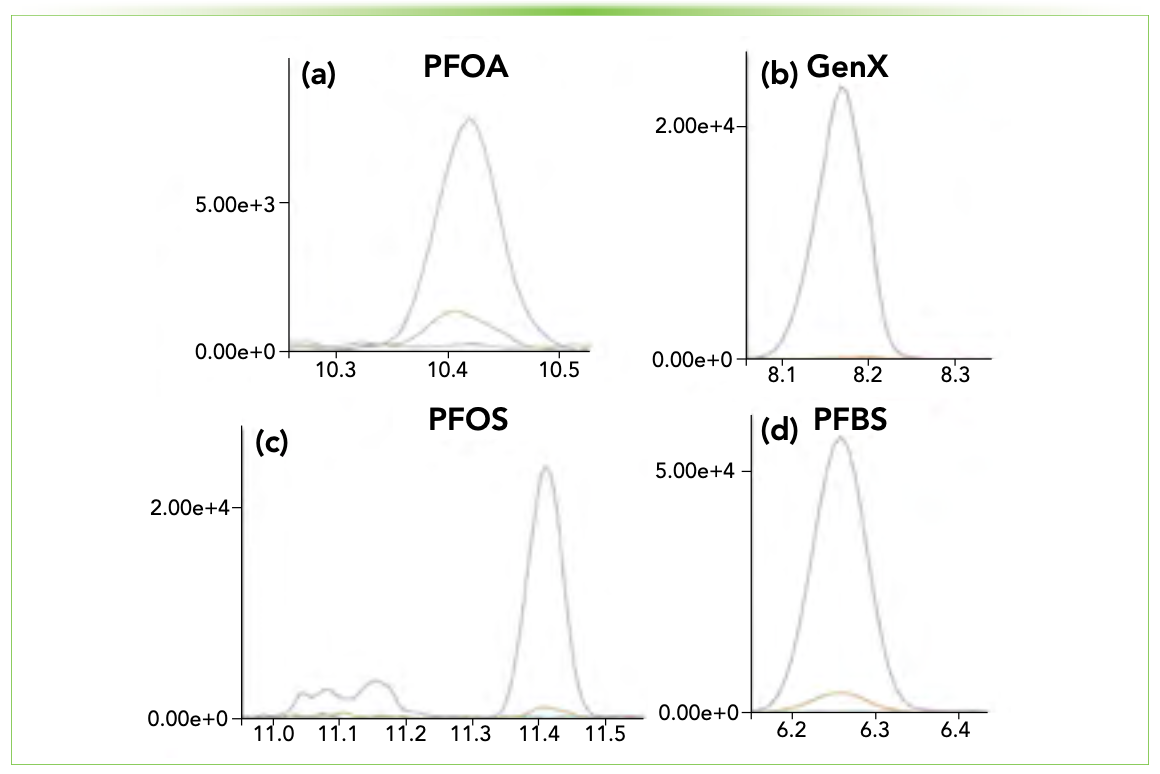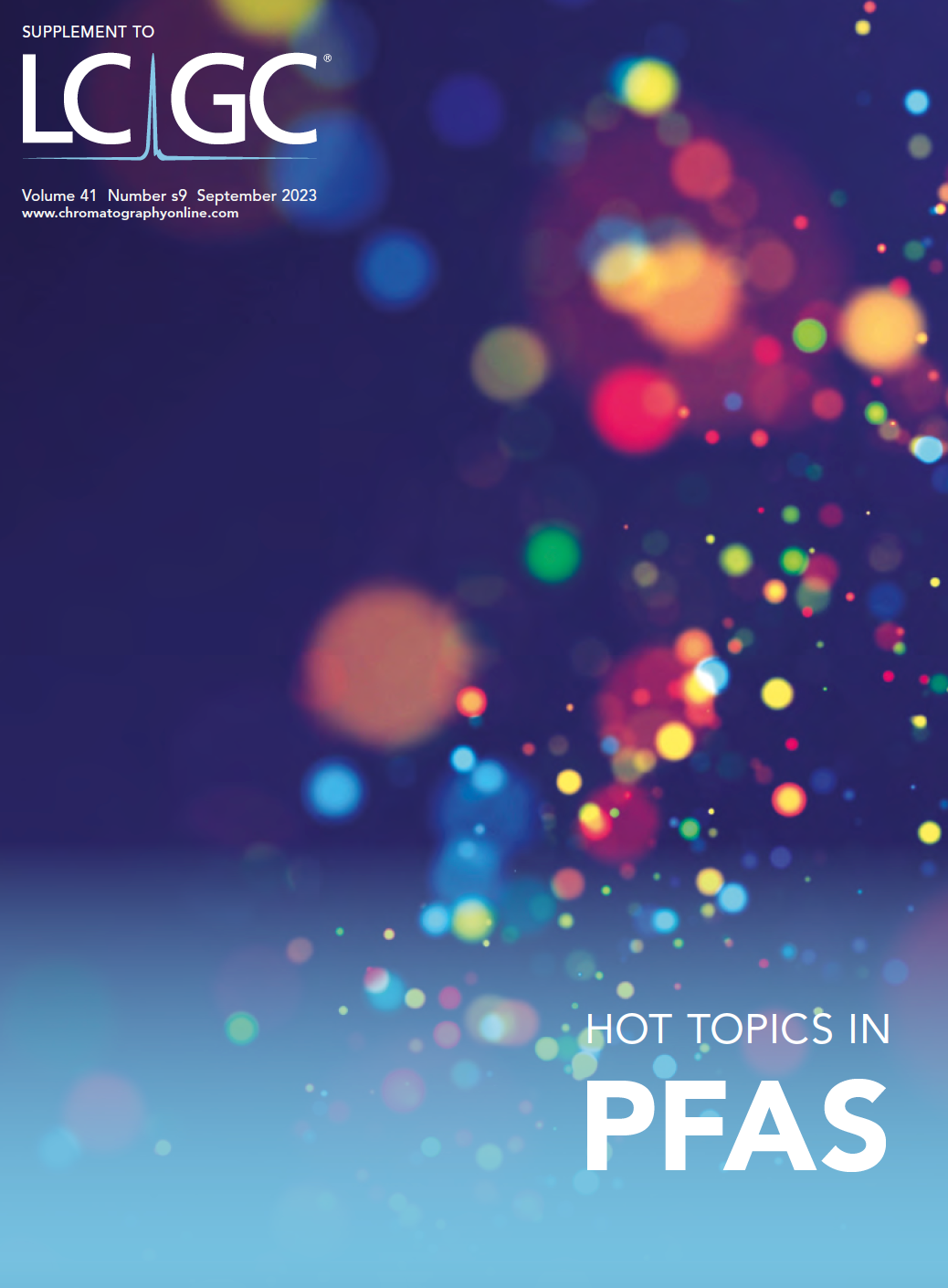Analytical Techniques in Exploring the Persistent Global PFAS Problem
Per- and polyfluoroalkyl substances (PFAS) are synthetic chemicals with unique properties. They are used in a wide range of different industries because they repel water and oil, and they are heat-resistant. However, PFAS contamination has become a widespread global concern because of their ubiquitous occurrence, persistence in the environment and living organisms, and potential health risks. Governments around the world are continuously introducing and updating regulatory limits for PFAS in drinking water, other types of water, biota, and, most recently, food. Analyzing such a wide range of sample types for PFAS requires high sensitivity and selectivity, typically provided by methods based on advanced liquid chromatography–tandem quadrupole mass spectrometry (LC–MS/MS) instrumentation. However, one critical aspect to sampling and analyzing PFAS accurately is to avoid PFAS contamination during these processes. This paper emphasizes the significance of robust and reliable PFAS analysis to support efforts to mitigate the global PFAS crisis. Collaboration, research, and advanced analytical solutions are essential to safeguard food, water, and the environment, thusly reducing the impact of PFAS on public health and the environment.
Per- and polyfluoroalkyl substances (PFAS) are synthetic chemicals with a myriad of industrial and cosmetic uses, and they contain unique properties that enable them to repel oil and water as well as being resistant to heat. Common uses include firefighting foams, water-resistant and non-stick coatings, waterproof mascara, floor polishes, and oil-resistant coatings for paper products approved for food contact.
- Currently, there are thousands of known PFAS with more than 600 permitted for use in the United States alone. Despite decades of research on PFAS, fundamental barriers remain to addressing worldwide contamination by these chemicals and their associated impacts on environmental quality and health. What we do know is that three of the most researched PFAS compounds (perfluorooctanoic acid [PFOA], perfluorooctane sulfonic acid [PFOS], and perfluorohexane sulfonate [PFHxS]) have shown adverse health effects in people (1–3).
- They are highly mobile, ubiquitous, persistent, and toxic environmental contaminants that accumulate in humans, animals, and the environment.
- They are characterized by their high chemical stability, enormous structural diversity, and consistent presence in both the scientific literature and mass media.
- The basic structures of PFAS consist of a carbon chain with substituted fluorine atoms replacing hydrogen atoms on the chain.
- Different categories of PFAS can be grouped based upon the different substituents and functional groups within or terminal to the chain.
Dietary intake is considered as one of the main human exposure pathways of these chemicals. Once they enter the human body, PFAS do not metabolize and instead can accumulate in tissues as mentioned previously.
Regulatory Framework Around the Globe
As advisory and regulatory limits continue to be created and updated to protect public health and the environment, detection requirements for PFAS have been getting more demanding. For example, on June 15th, 2023, the U.S. Environmental Protection Agency (EPA) tightened its lifetime health advisory levels in drinking water for PFOA and PFOS. The proposed interim level for PFOA is 0.004 ng/L, or four parts per quadrillion (ppq), currently the lowest recommended level. As an analogy, think of trying to identify four specific ants out of all the estimated one quadrillion ants on the planet! Since then, in March 2023, the U.S. EPA proposed establishing legally enforceable levels for six PFAS (PFOA, PFOS, perfluorononanoic acid [PFNA], hexafluoropropylene oxide dimer acid [HFPO-DA], PFHxS, and perfluorodecane sulfonic acid [PFBS]) in drinking water as part of the National Primary Drinking Water Regulation (4). The proposed maximum contaminant levels (MCLs) for PFOA and PFOS are 4.0 ppt while the remaining are based on a “Hazard Index”.
Other established drinking water maximum levels of PFOA and PFOS are 80 and 40 ng/L in China (5), respectively, whereas those in Australia are 560 and 70 ng/L, respectively (6). As stated in the Official Journal of the European Union, “By 12 January 2024, the Commission shall establish technical guidelines regarding methods of analysis for monitoring of per- and polyfluoroalkyl substances under the parameters ‘PFAS Total’ [totality of all individual PFAS should not exceed 500 ng/L] and ‘Sum of PFAS’ [sum of PFAS in Part B of Annex II should not exceed 100 ng/L], including detection limits, parametric values and frequency of sampling” (7).
The first regulatory limits for some PFAS in some foods of animal origin have recently been agreed to in Europe alongside recommended indicative limits in many other foods. Commission Regulation (EU) 2022/2388 (8) that amended Regulation (EC) No 1881/2006 was enacted on January 1st, 2023, and it set mandatory individual maximum levels for a limited number of PFAS (PFOA, PFOS, perfluorononanoic acid [PFNA] and perfluorohexane sulfonic acid [PFHxS]), together with a maximum level for the sum of those PFAS, in various foods of animal origin. The regulation was restricted to food of animal origin because this group was thought to be the most important contributor to human exposure to PFAS. Maximum levels, depending on the commodity, range from 0.2 to 50 μg/kg. As you can see, where maximum or advisory limits exist for water and food, the actual specific PFAS, as well as the maximum limits themselves included in the legislation, varies significantly between or even within regions.
Quantifying These Persistent Pollutants
Reliable analytical methods are needed to check compliance with regulatory limits and to determine exposure. For routine monitoring and research purposes, detection of PFAS to the ng/L, ng/kg, or part-per-trillion (ppt) level requires the use of liquid chromatography–tandem quadrupole mass spectrometry (LC–MS/MS). Although avoiding sample preparation may improve laboratory throughput, as well as reduce potential sources of contamination, a sample preconcentration step can be used for that ultimate method sensitivity.
With so many common sources (9) of PFAS contamination in our everyday environment, it can be difficult to routinely achieve such low-level analysis. Although complete avoidance of PFAS is impossible, steps can be taken to minimize background contributions. In the field, caution should be taken to avoid Teflon-containing materials such as waterproof clothing, plastic clipboards, and chemical ice packs. In the laboratory, items to avoid include sticky notes, certain glass disposable pipettes, vial caps with Teflon seals, and low density polyethylene (LDPE) containers. Detergents and personal care products used in the laboratory, used to launder laboratory coats or worn by scientists should also be considered possible contamination sources. It is recommended that all laboratory supplies be checked for PFAS contamination before use in the analysis.
FIGURE 1: Overlaid chromatograms are shown for solvent blanks (green), extraction blanks (orange), and spiked extracts (blue) for (a) PFOA at 0.004 ng/L; (b) GenX at 0.02 ng/L; (c) PFOS at 0.02 ng/L; and (d) PFBS at 0.02 ng/L. Axis labels are time (min) for x-axis and intensity for y-axis.

Conclusion
Although not all countries have testing requirements in place, a good number of proactive steps are being taken by others. In response to growing evidence of the harmful effects of PFAS, many changes and regulations have been proposed around the world. The impact of PFAS continues to be researched and our understanding improved. Waters’ PFAS solution – including quality controlled sample preparation, flexible data management tools, PFAS specific training, along with certified reference materials and proficiency testing – is helping scientists determine PFAS at very low levels and study their persistence and toxicity, as governments work to develop plans to remove them from our environment. Through customer collaboration, we continue to refine and improve our solutions that enable scientists and innovators around the world to ensure the safety of food and water. It is part of our overall commitment to leave the world better than we found it.
References
(1) OECD, Co-operation on existing chemicals: Hazard assessment of perfluorooctane sulfonate (PFOS) and its salts. (ENV/JM/RD(2002) 17/FINAL). 2002. https://www.oecd.org/env/ehs/risk-assessment/2382880.pdf
(2) UNEP, Risk profile on pentadecafluorooctanoic acid (CAS No: 335-67-1, PFOA, perfluorooctanoic acid), its salts and PFOA-related compounds (UNEP/POPS/PORC.12/11/Add.2). Secretariat of the Basel, Rotterdam and Stockholm Conventions, 2016.
(3) UNEP, Risk profile on perfluorohexane sulfonic acid (PFHxS), its salts and PFHxS-related compounds (UNEP/POPS/PORC.14/6/Add.1). Secretariat of the Basel, Rotterdam and Stockholm Conventions, 2018.
(4) U.S. EPA, Per- and Polyfluoroalkyl Substances (PFAS) Proposed National Primary Drinking Water Regulation. U.S. EPA 2023. https://www.epa.gov/sdwa/and-polyfluoroalkyl-substances-pfas (accessed 2023-05-02).
(5) State Administration for Market Regulation of the P.R. China; National Standardization Administration, Standards for Drinking Water Quality, GB5749-2022. Published 15 March 2022; Implemented 01 April 2023.
(6) Australian Commonwealth – Department of Climate Change, Energy, the Environment and Water. Australia and New Zealand PFAS National Environmental Management Plan V2.0 – January 2020. Commonwealth of Australia 2020. https://www.dcceew.gov.au/sites/default/files/documents/pfas-nemp-2.pdf (accessed 2023-05-02).
(7) EUR-Lex. Directive (EU) 2020/2184 of the European Parliament and of the Council of 16 December 2020 on the quality of water intended for human consumption. The European Union 2020. https://eur-lex.europa.eu/legal-content/EN/TXT/PDF/?uri=CELEX:32020L2184 (accessed 2023-05-03).
(8) EUR-Lex. Commission Regulation (EU) 2022/2388 of 7 December 2022 amending Regulation (EC) No 1881/2006 as regards maximum levels of perfluoroalkyl substances in certain foodstuffs. OJ L 316: 38–41. The European Union 2022. https://eur-lex.europa.eu/eli/reg/2022/2388/oj (accessed 2023-05-02).
(9) Zintek, L. B.; et al. Region 5 CRL Methods for the Analysis of Polyfluorinated Compounds (PFCs) Using a Quick Sample Extraction/Preparation Followed by UPLC/MS/MS Analysis. In National Environmental Monitoring Conference, Washington, D.C.; Presentation 2017.
Simon Hird, Warren Potts, and Ken Rosnack are with Waters Corporation. Direct correspondence to: Ken_Rosnack@ waters.com

University of Tasmania Researchers Explore Haloacetic Acid Determiniation in Water with capLC–MS
April 29th 2025Haloacetic acid detection has become important when analyzing drinking and swimming pool water. University of Tasmania researchers have begun applying capillary liquid chromatography as a means of detecting these substances.

.png&w=3840&q=75)

.png&w=3840&q=75)



.png&w=3840&q=75)



.png&w=3840&q=75)








